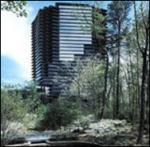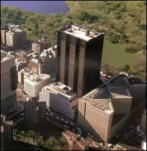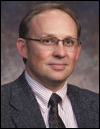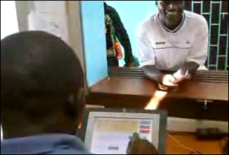From Dr. Yes: “Re: athenahealth. Because of the big deal Athena did today, Jonathan Bush was just on CNBC. He was almost as funny as he was at your HIMSS party. The guy is truly charismatic. I’ll bet the stock goes wild.” The company bagged a big win today, signing University Hospitals of Cleveland (450 doctors) for revenue cycle services. The stock was actually down around 1% today even with the early morning announcement, but the market was down overall.

From Clarence Trauma: “Re: Orlando Health’s Web site. Are women are not adults, or possibly in this politically correct world, are men are no longer referred to as such, but rather addressed merely as Adults? Or, based on the cozy couple next to the Adults button, maybe they’re tapping into the XXX market.” I’m not a fan of the pinkish-red design, I’ll say that. The marketers have been allowed to run amok, obviously, given the biggest headline on the page: Learn About Our New Brand. Your Brand is like your high IQ or dynamite sexual prowess — don’t yap about it constantly; let the few people who care arrive at that conclusion themselves.
From Shawn Spencer: “Re: Tom Skelton. Going to work at MED3OOO, supposedly, maybe to run sales and work up from there. There’s a Pittsburgh connection and some former Misys people at MED3OOO.”
From Songbird: “Re: Hayes Management Consulting. They reportedly laid off consulting staff this week.” We have a contact there since they’re a sponsor (Pete Butler, president), so Inga asked him. “It is always interesting to see how rumors can get blown out of proportion. On January 13th Hayes did make a 7% reduction in force. Some segments of our business are exhibiting significant growth while other segments have slowed due to vendor slowdowns and market conditions. We continue, however, to hire selectively in areas that we have identified as growth areas for Hayes. As the unprecedented economic uncertainty continues to challenge the healthcare industry everyone is being compelled to make adjustments. We consider ourselves fortunate that our adjustments are small relative to those of the industry. We credit this to Hayes’ history of being a well run company that has grown prudently over the years. In 2008 we experienced 15% revenue growth over 2007. We expect our revenues to continue to grow in 2009 including in areas of federal initiatives in Health IT. We remain committed to building long term trusted relationships and we look forward to continuing to serve our clients for many years to come. Honestly Inga, this was a difficult action for us to take and one Hayes has never taken before. We consider all of our employees close members of the Hayes family yet we need to remain good stewards of this company in these challenging economic times. We have a confident outlook for 2009 and continue to experience growth as we kick off this New Year.” Hayes runs a good shop and is #1 in KLAS in overall services, so you can bet it’s not just them. And if you know which areas they pruned back, you’d also know which systems vendors are struggling since it’s a direct relationship.
From Mr. G: “Re: Eclipsys. According to MorningStar analysts, 40% of Eclipsys’ revenues are attributable to the 20 largest clients. One client represents 10% of revenue. Does anyone know who this client is?”
From Carol Dedmon: “Re: Jeff’s comment. Jeff is a sourpuss – the whole freaking world is celebrating a new beginning and our industry is hopeful of renewed energy and investment. He slaps you down with a ‘mind your knitting’ remark. Jeff left a curt comment on Tuesday’s post saying he was tired of the Obamafest (his word) and that only political pundits should discuss such sensitive topics like the inauguration. I compared Obama’s speech to Jimmy Carter’s, so I figure Jeff was sniping at a brief Inga mention since she’s gushier than me. Well, no hard feelings. At least I found someone even more cynical than me.
From ORISpilot: “Re: Alert. The president of Alert Life Sciences publicly berates the executive sales team from North America for low Q4 sales in front of a large crowd at its annual retreat in Portugal. Staff are being let go.” Unverified. They made a big splash at HIMSS in 2007, but I haven’t heard a word since and had completely forgotten about them. I don’t see anything about US customers on their site, which claims $34 million in 2007 sales but no 2008 number yet. I remember it as being exceedingly cool, but the US is a tough market to crack from Portugal. Or here.
From Spencer Haywood: “Re: HealthVault. I signed up for Microsoft’s HealthVault and starting playing with it. You can enter e-mail addresses to give others access to your records. You can choose spouse, domestic partner, … and pet. Good thing my cat signed up for Gmail last week. Not on the list: provider or physician. Guess my cat needs access to my record more than my doctor.”
Listening: Fiction Family, brand new duo pop, not my usual cup of tea, but some nice hooks. One guy’s from Switchfoot, the other from Nickel Creek (for bluegrass fans like me).

Not available in Hallmark stores: e-cards that allow people to anonymously notify sex partners that the sender has a sexually transmitted disease. Noting that gay men often exchange bodily fluids but not e-mail addresses, health departments are also setting up profiles on gay Web sites as an outreach. I don’t know how well it works, but it’s certainly worth trying.
HISsies voting. Be there. Thanks.
You may have noticed that industry news is picking up quite a bit, as is HIStalk readership (keeping me extremely busy). If you don’t get the e-mail updates, you might want to sign up over there to your right. That list is up to over 3,500 confirmed, active subscribers, so everybody will be walking around knowing stuff you don’t if you don’t sign up. It would be cool if we hit the 2 millionth visit by HIMSS, but I’ve counted on my fingers and I don’t think it will quite make it. Still, I’m staggered to have that many folks reading, so thanks much for that. I’m really honored by the number of people who e-mail nice comments and tell me how important HIStalk is to them (Mrs. HIStalk isn’t one of them since she feels she’s been denied my consort, but I’ve tried to explain the whole HIT thing and she just glazes over).

Eclipsys shares hit a five-year low after the company announced low Q4 preliminary earnings yesterday. Shares closed at $8.01, down over 29%, giving ECLP a market cap of just $438 million. I don’t get the primary excuse, that customers planning to go with a traditional license purchase decided to take a subscription license instead and therefore delayed revenue. First, ECLP must be offering bad subscription terms if customers were even considering buying a license instead of stretching out the payments by subscription. Second, the company has always said that the subscription model would provide a nice recurring income stream, which still isn’t clear after all these years. The good news for them is that Cerner doesn’t seem to be making any new sales, but the bad news is … well, Epic’s everywhere you turn, especially when your product line is limited. ECLP has made some nice acquisitions in MediNotes and EPSi, current management is better than the old regime, and the yearly numbers still look good, so here’s my impression: the company needs to fix some problems, but this may just be the first wave of bad news when it comes to the big iron boys whose only customers are cash-strapped hospitals.
Maybe J&J will buy them. Drug maker Johnson & Johnson is not expecting a great 2009, but is still looking to pick up some acquisitions that have had the wind knocked out of their sales (pun intended) by the recession. The CEO says he’s especially interested in healthcare information technology and wellness and disease companies.
More layoffs at GE’s Burlington office. Songbird had tipped me off that it would happen yesterday and he or she was right.
I heard (indirectly) from a consultant who just lost his ambulatory EHR consulting job after the main vendor his company supports (I won’t name them, but they’re big) had major product issues, causing users to put upgrades on hold, which dropped the demand for consultants. His employer was small, so they didn’t have the resources to cross-train people on products with a higher consultant demand. The person who passed his message along is considering dropping that same vendor’s product and moving to another vendor, possibly eClinicalWorks.
Some Houston fans of open source software in healthcare are holding a July 31 weekend conference, promising good speakers and some cutting edge companies. Only $60 if you sign up stat.
Microsoft was to have laid off 1,400 people Thursday, the first wave of an eventual 5,000 jobs cut in the company’s first-ever layoff. Q2 profits were down by 11% and the company declined to forecast earnings for the rest of 2009. Also announced: travel budgets have been cut, salaries are frozen, and physical expansion of the Redmond campus has been scaled back. Shares were down almost 12% today, dragging the entire market down with them.
Microsoft’s arch-competitor Google did a little better, maybe. The company just announced Q4 numbers: revenue up 18%, but earnings were down 68%, the first time in the company’s history that earnings dropped. It, too, laid off employees, but just 100, and also wrote down most of its $1.5 billion investment in AOL and Clearwire. Cost control was obviously excellent. Shares are up.

A fire broke out at Mount Sinai Medical Center (NY) Thursday, forcing the horizontal evacuation (my HEICS training shines) of 600 patients. Flames were visible from Madison Avenue, but the fire was contained to a mechanical room and was put out with no injuries reported.
Internet inauguration watchers overloaded the network pipes at University of Kansas Hospital (KS), causing patient records to be unavailable for around 30 minutes. An e-mail was sent telling employees to get off, which apparently worked.
TriZetto’s CEO says that government and payers are going down the wrong road with EHRs. “For example, the new Obama administration is promising to spend a good portion of a $50 billion investment with physicians to adopt EHRs and the infrastructure to share them. But, those plans indicate that many in Washington are overlooking a faster, far less costly path to ubiquitous PHRs. Health plan information systems are the single richest repository of comprehensive diagnostic and treatment data and benefits information in the entire U.S. healthcare system. Both government and payers are missing a key opportunity.”
St. Clare’s Health Services (NJ) fires five VPs so the CEO, who’s been there since last May, can bring in his own people. He told employees that operational changes are being considered, but a source tells me that hundreds of employees will be laid off in the next few weeks.
Thanks to Barbara Benson, a reporter for Crain’s Health Pulse and Crain’s New York Business, who e-mailed me to let me know that she had written about NYU’s $186.4 million Epic project. Having run across it while researching the state’s certificate of need records, she checked HIStalk to get some background (it was reported here back in July by Motown HITman and Mad Man). They told her that Eclipsys Sunrise won’t go away, which seems highly unlikely. Here’s what Mad Man said then: “I have heard, from multiple sources, that NYU is moving off of Eclipsys to Epic because Epic provides a comprehensive (i.e., inpatient, ambulatory, physician EMR) solution where Eclipsys XA does not. I find this very interesting since NYU just went live with XA to much hoopla in the trade papers. The system move has caused a lot of chaos in the NYC Eclipsys office.”
John Glaser gets a Wall Street Journal mention in a political story about the economic stimulus. He warns that trying to spend a bunch of federal healthcare IT money too fast may be wasteful and counterproductive, especially if systems are slammed in without regard to the needs and work flow of users. I agree, but Uncle is looking for some fast spending, so here’s a question: if you were doing the disbursing, which projects would you choose that would require hiring lots of people, have good oversight already in place, and are ready to provide near-immediate return on investment?

I think Marshfield Clinic CIO Bob Carlson agrees. In Part II of an excellent interview, he says, “Implementing an EMR can be a very dangerous thing. There are studies that show that given the complexity of healthcare, it’s easy to miss steps in processes and delay important information; in essence, instead of a positive impact on healthcare, if done wrong it may actually be a step backward. That being said, EMR is the first step toward moving healthcare where it needs to go. Once you’re in the electronic format, now you have the ability to take all the tools, the technology, the intelligent assistants, the data mining and trend analysis, and the outcomes and start bringing them to bear where the rubber meet the road – at the point healthcare is being delivered.”
An audit of California’s prison medical system finds that $27 million in technology contracts were issued without legally required competitive bidding. One IT manager was fired in June for being involved, although there was no evidence that the prices were out of line or that employees benefited.
RSNA 2008 did OK considering the economy, with attendance, exhibitors, and exhibit square footage down only in the single digits. Will HIMSS be so lucky, especially since they’re in Chicago for the first time, in April instead of February, and starting on Saturday?
Hospital layoffs: King’s Daughters Medical Center (MS), 21; Memorial Medical Center (PA), 47; Providence Saint Joseph Medical Center (CA), 94; Blue Hill Memorial Hospital (ME), 15; Excela Health (PA), 70; Butler Hospital (PA), 18; Southcoast Hospitals (MA), 12; Grenada Lake Medical Center (MS), 14.
Saint Luke’s Health System (MO) adds ePharmacy to its eICU center, scanning physician paper orders to a remote pharmacist for computer entry, which releases the correct meds from the dispensing cabinets for nurse administration.
Duke University School of Medicine gets a $1.25 million federal grant to develop an infectious diseases ontology for Staph aureus.
Cardinal Health fires an employee for refusing to work Sundays, saying they told him he could take off, but only if he arranged his own coverage. The employee, a minister, is appealing to a higher power – Charlottesville Federal Court, where he’s suing Cardinal for religious discrimination.
E-mail me.
HERtalk by Inga
From Mikey Likes It: “Re: LinkedIn photo. Nice shoes.” So far I have made it a week with my contraband LinkedIn photo. I have the same kind of feeling I did when a bouncer would let me into a bar, even though I was underage. (Geez, I hope my mother isn’t reading this.) I see the HIStalk Fan Club has swelled to 511 members, so we’ve all got to get together sometime.
In case you missed Mr. H’s recent commentary for Inside Healthcare Computing (The Obama-HIStalk Digital Stimulus Grants: Why Letting Me Hand Out the Freshly Printed HIT Cash Makes Sense), he is angling for the chance to hand out $20 billion of economic stimulus money at HIMSS. Personally I think his approach makes as much sense as anything else we have seen recommended so far. Plus it might help boost conference attendance (and thus stimulate the Chicago economy, no doubt), I’m thinking if he gets that gig, I will follow behind him and film the whole thing to post on YouTube.
Just in time to train people to on ways to spend all that economic stimulus money, American Sentinel University (CO) adds a Bachelor of Science degree program in Health Systems Management.
AHRQ releases a series of new reports highlighting the lessons and best practices from the recipients of AHRQ grants. The reports focus on the implementation and use of such technologies as CPOE, EHR, and BCMA.
Minnesota’s attorney general sues Allina Health System for charging illegally high interest rates. The lawsuit contends that Allina charged as much as 18% on unpaid medical bills, which is substantially higher that the 8% cap allowed under the state’s usury laws.
The recession and rising unemployment rates creates unprecedented increases in Medicaid rolls. Many states are seeing 5-10% more Medicaid recipients than a year ago. Growth rates have at least doubled from the previous 12 months.

Earlier this week Mr. H mentioned that Haywood Regional Medical Center (NC) named former EDI and McKesson leader Sheldon Tyndall as interim director of IT. Haywood is bringing on a new CFO, Gene Winters, who has served as CFO HCA, Acadia Healthcare, and Transitional Hospital Corp. Haywood made headlines last year following a temporary loss of Medicare and state certification after inspectors found potentially dangerous problems with medication administration. The story included whistleblowers, lawsuits, and a replaced CEO. Tyndall’s most pressing challenge is to complete the hospital’s EMR implementation.
I must confess that when I heard the names of this new Web site, I immediately envisioned some sort of virtual haircut, or at least someone like Vidal Sassoon administering the latest hairstyling advice. Elsevier announces eClips Consult to help physicians identify and assimilate information from professional medical journals.
Highmark Inc. and Independence Blue Cross announce they are withdrawing their merger applications with the Pennsylvania state insurance department. The companies believed the transaction would not be approved because the state insurance department believed it would adversely impact competition.
Precyse Solutions and Ingalls Memorial Hospital (IL) sign a five-year outsourcing agreement. The $4 million deal includes technologies and services to support Ingalls’ medical transcription functions.
Yalobusha General Hospital (MS) chooses a financial system from Healthcare Management Systems for its 26-bed hospital and two rural health clinics.
Partners HealthCare (MA) selects MDsoft’s MetaVision for acute care and preoperative technology. The system will be used at both Mass General and Brigham and Women’s Hospital.
Oasis Medical Solutions, a UK HIT provider, appoints Chris Spence, formerly with GE Healthcare IDX, as CEO.
Anne Arundel Medical Center (MD) implements VISion: Asset Management by Versus Technology, an RTLS solution the hospital is using for asset tracking.
Edward Hospital (IL) successfully deploys InfoLogix for wireless asset tracking.
Clara Maass Medical Center (NJ) selects Axolotl to support its HIE initiative.
Baptist Healthcare System (KY) signs with McKesson to manage the revenue cycles of its affiliated physicians. The deal includes McKesson’s Revenue Management Solutions group overseeing all facets of the physician billing and collection process. McKesson, by the way, was just named the #1 place to work for Six Sigma professionals.
Nuance Communications appoints a new head of marketing for its India operations.
MEDSEEK announces a new Webinar entitled Hope is Not a Strategy: Neither is Web 2.0 for a Hospital.
E-mail Inga.
Are Portals Becoming Obsolete?
By Robert Connely, Medicity
I wanted to add a comment to the question you raised – are portals becoming obsolete?
From my perspective, it’s a bit like asking the question “Have mainframe computers become obsolete?” The answer is, of course, that they have not. They have gotten smaller and faster, but they’re still in place, doing their work day-in and day-out. By the same token, portals are not obsolete, they’re just not sufficient by themselves to address all of the information needs of an organization like a hospital in today’s world.
I believe that hospitals need to think more broadly in terms of what I refer to as an “information outreach” strategy. Let me explain.
Today’s CIO is faced with a plethora of requirements that they’re charged with addressing, including:
- Providing remote access to physicians that need data that’s often found in multiple systems
- Exchanging information with an affiliate physician’s EMR
- Participating in the sharing of information in initiatives like HIEs or RHIOs
In these three common examples, there is often a desire to use a single technology to address all of them. This is, of course, nothing new.
When portals emerged in the late 90s, CIOs would say, “I already have a remote access solution – why use a portal”? The answer was that portals made it simpler for physicians to access a broad range of data from a single, personalized view. As advanced features like electronic signature emerged and physicians could perform useful work remotely, the use of portals expanded.
When new technologies like agent grids evolved to push data to EMRs in the early 00s, CIO’s would say, “I already have a portal – why do I need an exchange solution”? The reality is that if you have an EMR, accessing data f rom the portal is no longer acceptable. Instead, you want the data pushed to the EMR, where it can be viewed alongside other data on the patient collected by the physician.
rom the portal is no longer acceptable. Instead, you want the data pushed to the EMR, where it can be viewed alongside other data on the patient collected by the physician.
In the mid 00s when RHIOs and HIEs emerged, CIOs would either say, “I have an exchange solution, so I don’t need the HIE”, or, “I’m planning to join the HIE, so I don’t need an exchange solution.” As we learn more and more about this emerging world, it is clear that the needs of sharing information in an HIE is quite different that those required to exchange data with an EMR. Considerations like identifier reconciliation, local queuing of information if participating in a federated HIE, and others must be addressed by the chosen technology.
Now add the fact that hospitals serve a large number of physicians who are themselves at various levels of technology use and it becomes clear that there will always be physicians who need to interact with the organization in a variety of ways.
Thinking in terms of an information outreach strategy accepts this condition as a fact that must be dealt with to enable the organization to conduct business. It will likely require an array of technologies to address these varied needs. Because, just as you would never play a round of golf with just a putter, why try to use a single technology to address a wide range of information needs that are substantially different? It will only do one thing well, and everything else poorly. I suggest that instead, we think more like a golfer and have at our disposal a broad array of technology “clubs” to ensure that we have the right one for the shot we need to make.
Using this logic suggests that:
- Portals will continue to be useful in addressing the needs of physicians who either don’t have an EMR or want to access inpatient data that they don’t want in the EMR (physicians often elect to not receive inpatient lab tests in their EMR), or to perform workflow functions like signing off reports that are generated within the hospital.
- EMR exchange solutions must be put in place or risk losing business to another hospital or lab that accepts orders and delivers results electronically to and from the EMR. While it’s true that only 17% or so of physicians use an EMR, these tend to be larger, high revenue-generating practices that few hospitals can afford to lose to the competition.
- As HIEs evolve, the CIO may one day be told that the organization must participate in the initiative, which requires new consideration to what it means to “publish” information to the entity or entities (multi-system organizations often are required to participate with many local HIEs). In this case, portals or EMR exchange strategies are by themselves insufficient, and newer technologies that cache data outside of the internal systems must be put in place, with mechanisms to interact with the HIE core that may or may not include Record Locator Services, Master Patient Indices, and the like.
There may come a time when portals finally do become obsolete (for example, I don’t imagine many hospitals still using analog dial modem banks for remote access), but I can clearly see them continue to play a significant, albeit not an exclusive role, in the hospital’s “bag” for many years to come.
































































"A valid concern..." Oh please. Everyone picks the software they like and the origin of that software is an afterthought.…